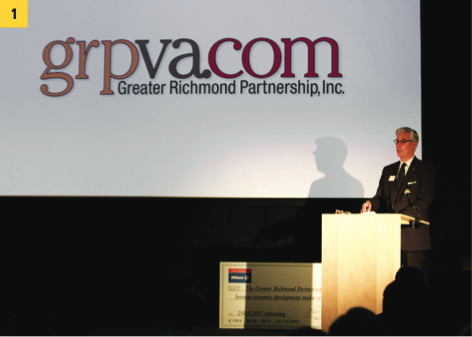Greg Wingfield, the president and CEO of the Greater Richmond Partnership, knows a thing or two about playing on teams. The 6-foot-5-inch former college basketball player has been forming bonds in economic development for around 35 years.
“When you look down the bench and can trust every player on your team, it means a lot,” says Wingfield. “Economic development is a team sport and when you have dedicated, supportive teammates like we do, something special can hap- pen. In economic development terms, it’s when a large project chooses the region for their expansion.”
For the last 19 years, the Greater Richmond Partnership has been attracting businesses worldwide to the Richmond region, and these efforts wouldn’t have been possible without four autonomous localities teaming up. Seventeen projects were worked by the Partnership last year, announcing jobs and capital investment in the
Partnership’s footprint, which includes Chesterfield, Ha- nover, Henrico, and Richmond. Some of the companies may sound familiar: The Vitamin Shoppe, Decadence Gourmet Cheesecakes, and Blue Bell Creameries.
“Since the beginning of the Partnership, nearly 450 projects have been worked by the GRP and local economic development staff members,” explains Daniel A. Gecker, member of the Chesterfield County Board of Supervisors and former GRP Board Chair. “If you include the local Busi- ness First volunteers and regional resource partners, that’s a large group of people looking out for the best interest of the region. Many localities don’t have that luxury and it’s one reason we’ve been so successful.”
As the Partnership enters the last fiscal year of its five- year funding cycle, two things remain clear: The Partnership continues to adapt to the worldwide economic climate, and business attraction remains challenging.
“As we move into our last year of this current funding cycle, our resources have remained the same, if not slightly decreased,” explains Wingfield. “The economy has changed the landscape of business, but we can’t continue to recruit large employers such as Sabra, MWV, and Amazon without public and private support.”
The Partnership has recently kicked off a fundraising campaign for a new three-year cycle beginning in 2014.
Metro Economy Exceeds State, National Growth in 2012
The river dog is now leading the pack.
The Richmond metropolitan statistical area’s economy in 2012 grew at a rate significantly higher than the increases seen in Virginia’s statewide economy, the nation’s 380 MSAs, and the national economy. And some economists are licking their chops.
“This information is as solid proof as you will find that our economy is getting back on the right track,” says Gregory H. Wingfield, president and CEO of the Greater Richmond Partnership, Inc., the economic development group representing the four largest localities in the MSA.
During 2012, the Richmond economy increased by $3.4 billion, or 5.2 percent, rising from $65.2 billion in 2011 to $68.6 billion in 2012, according to data released by the U.S. Bureau of Economic Analysis in September. The analysis was done using current, non-inflation-adjusted data.
During this time period the Commonwealth of Virginia’s economy rose by 1.1 percent, the combined increase for all 380 of the nation’s metro areas increased by 4.1 percent, and the national economy rose by 2.5 percent.
“Over the past few years our region’s economy continued to grow, but at a rate that was below the state’s and nation’s, but this has obviously turned around and we’re working every day to see that this trend continues,” says Wingfield. “Our recruitment efforts are focused on the industries that we believe are driving growth and include finance, business services, health care, logistics, and manufacturing.”
Only 38 of the nation’s 380 metro areas had actual increases in gross domestic product that exceeded Richmond’s increase of $3.4 billion, and only 66 metro areas had growth rates that exceeded Richmond’s rate of 5.2 percent.

